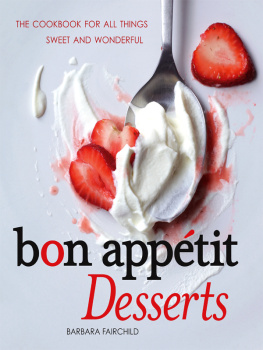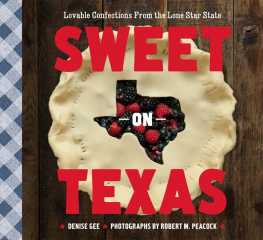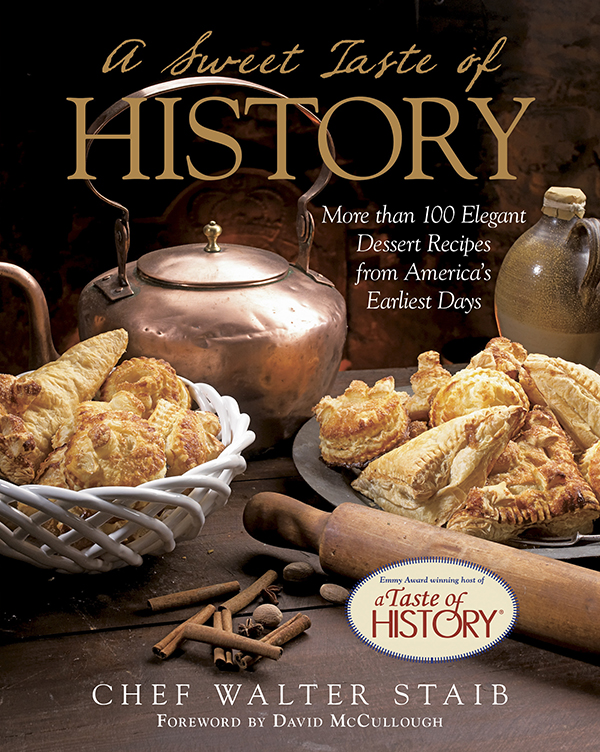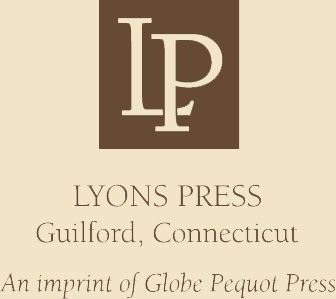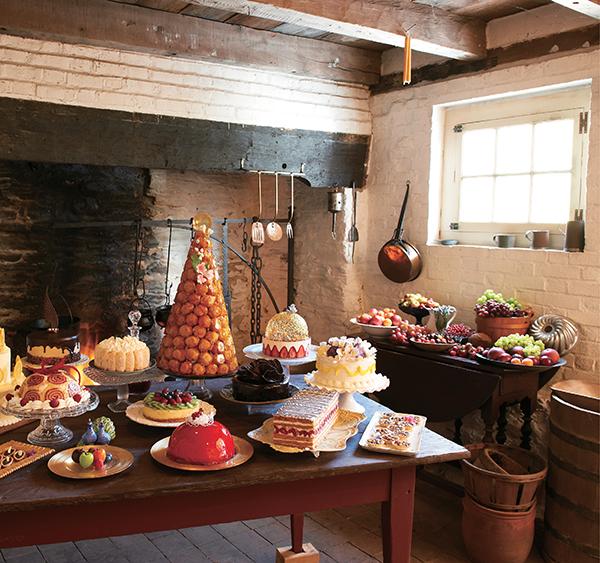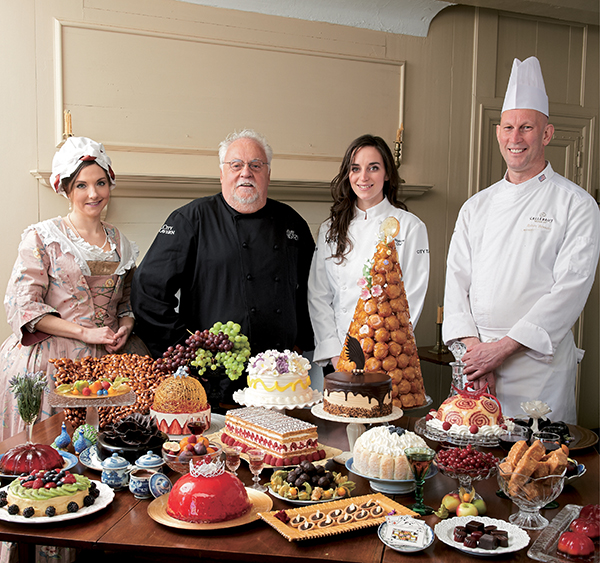A Sweet Taste of
HISTORY
BY THE SAME AUTHOR
City Tavern Cookbook
City Tavern Baking & Dessert Cookbook
Black Forest Cuisine
The City Tavern Cookbook: Recipes from the Birthplace of America
A Feast of Freedom
A Sweet Taste of
HISTORY
Chef Walter Staib
with Molly Yun and Diana Wolkow
Photographs by Todd Trice
Foreword by David McCullough
Copyright 2013 by Walter Staib
ALL RIGHTS RESERVED. No part of this book may be reproduced or transmitted in any form by any means, electronic or mechanical, including photocopying and recording, or by any information storage and retrieval system, except as may be expressly permitted in writing from the publisher. Requests for permission should be addressed to Globe Pequot Press, Attn: Rights and Permissions Department, P.O. Box 480, Guilford, CT 06437.
Lyons Press is an imprint of Globe Pequot Press.
Photos by Todd Trice, except for those on pages xx, 2, 5, 7, 9, 11, 13, 15, 122, 129, 133, 135, 150, and 170 by Molly Yun.
Text design and layout: Nancy Freeborn
Project editor: Ellen Urban
Library of Congress Cataloging-in-Publication Data
Staib, Walter.
A sweet taste of history : More than 100 elegant dessert recipes from Americas earliest days / Chef Walter Staib with Molly Yun and Diana Wolkow ; photographs by Todd Trice.
pages cm
Summary: From the chef and host of A Taste of History comes a beautiful cookbook that features 100 elegant dessert recipes from Americas earliest days and will capture the grandeur of the sweet tablethe grand finale course of an 18th century meal. At this time it was common for hostesses to arrange elaborate sweet tables that were designed as works of art. A Sweet Taste of History will blend American history with exquisite recipes and it will show the reader not only how to recreate these incredible desserts but will also discuss the importance of each one, the social story behind them, and how these dishes landed on the tables of early Americans Provided by publisher.
Includes bibliographical references and index.
E-ISBN 978-1-4930-0191-0 (ePub)
1. Desserts. 2. Cooking, American. 3. DessertsUnited StatesHistory18th century. 4. Cooking, AmericanHistory18th century. I. Yun, Molly. II. Wolkow, Diana. III. Title.
TX773.S78 2013
641.86dc23
2013027424
Contents
Foreword
Of all those worthy patriots who gathered for the first Continental Congress in Philadelphia in late summer of 1774and of those who later fixed their signatures to the immortal Declaration of Independencenone wrote so fully or candidly about the setting of the historic drama, or the human side of life for the protagonists, than did John Adams of Massachusetts. And quite fitting it is that Adams, describing his arrival in Philadelphia for the first time on August 29, 1774, singled out City Tavern for lavish praise. Indeed, to judge by John Adamss diary, the then-new hostelry on Second Street was the only thing about Philadelphia that made an impression that first day.
Adams and the others traveling with him had been on the road since early morning, and dirty and dusty and fatigued as they were, they could not resist the Tavern, where, Adams wrote, they received a fresh welcome, a supper... as elegant as ever was laid on a table. What time they sat down to eat he did not record, but it was eleven before they pushed back their chairs and called it a night, all of them, one gathers, departing amply fortified to face whatever might lay in store. For his part, Adams decided that here was the finest tavern in all America.
It was an endorsement few would have disputed, and it came from a man who dearly loved to eat, who all his life loved and appreciated good food, good drink, good talk around a convivial table.
Philadelphia in the late eighteenth century was the largest, most prosperous city in America, the busiest port, and a cornucopia without equal. Nowhere could one find such bountiful evidence of American abundance: such quantities of fresh fruit and vegetable, fresh fish, meats, sausages, wild game, and cheeses on sale; or such a variety of elegant cooking. Delegates from the far-flung colonies, visitors from abroadvisitors of all kindsmarveled at the produce on display at the citys enormous central market. Twice weekly, on market days, German-speaking country people rolled into the city in huge wagons laden with produce and live chickens, ducks, and pigs. One signer of the Declaration of Independence, Stephen Hopkins of Rhode Island, counted seventy farm wagons on Market Street.
In such an atmosphere, not surprisingly, minimalist cuisine was not the fashion. Dinner at City Tavern, or at any of the fine homes of Philadelphia, could include twenty or more different dishes, not counting dessert. As John Adams reported to his wife, Abigail, even plain Quakers served ducks, hams, chicken, and beef at a single sitting, while such desserts as served at the home of Mayor Samuel Powel on Third Street were dazzlingcustards, flummery, jellies, trifles, whipped syllabubs, floating islands, fruits, nuts, everything imaginable.
But for the delegates to the Congress, City Tavern remained the great gathering place. It was there that Adams and George Washington first met. It was there that so many came and went, not yet figures in history, but flesh-and-blood human beings, let us never forgetSam Adams, Richard Henry Lee, Patrick Henry, Thomas Jefferson, Benjamin Franklin, Dr. Benjamin Rush. And here they made history, shaped much about the world we live in, with what they said among themselves, bargaining, politicking, speaking their minds, talking small things and large over the rattle of dishes and the steady hubbub of surrounding tables. Nothing of what was said was recorded. No artist is known to have sketched such scenes.
The original City Tavern is gone. The present City Tavern, on the same site, is an exact reproduction. Still, the feeling of entering another time is strong and appealing, and it makes City Tavern a must experience for anyone with even a little interest in historyand most especially when the food comes on.
The great pull of the place is the same as long before, with the marvelous array of things to eat. Under the direction of chef/restaurateur Walter Staib, the offerings are never static, never routine, any more than in days of old, when the likes of Adams and Washington climbed the marble stairs to the front door. That this sumptuous cookbook, devoted solely to desserts and breads, contains no fewer than one hundred tantalizing receipts certainly makes the point.
The founding era of America, now more than two centuries past, was a vastly different time from our own. The people, too, were different, and more so than generally understood. Yet it is possible to make contact with them as fellow human beings. We can enter their world, we can come to know them through the letters they wrote, their diaries, the books they read, their music, their architecture, the ways they worshipped, the poetry they loved and learned by heart, and yes, God be praised, by the food they ate.






